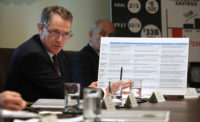Architecture firm business conditions continued to soften in October, with the American Institute of Architects/Deltek Architecture Billings Index score declining to 44.3, as more companies reported decreased billings. The index stood at 44.8 in September and at 48.1 in August. Any number below 50 indicates a net decline in billings from the previous month.
The index, which serves as an economic indicator that leads nonresidential construction activity by about 9 to 12 months, is based on responses from AIA member firm participants on whether their billings increased, decreased, or stayed the same in the month that just ended. Based on the proportion of responses to each option, a score is generated that represents an index value for the month.
Indicators of future work in the pipeline also stumbled—with AIA member firms reporting a decline in inquiries into new projects for the first time since July 2020. The value of newly signed design contracts also softened for the third consecutive month. These results show that fewer clients are exploring and committing to new projects, which could affect future billings, AIA said.
Billings were universally down across the entire country in October, with firms located in the West and Northeast continuing to report the softest business conditions overall for the second month in a row. The pace of the decline remained slower at firms located in the Midwest and South but it still continued for the third and fourth consecutive month, respectively. By firm specialization, billings declined slightly for those in institutional markets but they remained extremely weak for those in multifamily residential work and continued to soften significantly for companies focused in the commercial/industrial sector.
Jobs Decline at Architecture Firms
The architecture services industry continued to shed jobs in September (the most current data available), declining by an additional 500 jobs, an AIA statement said. While employment in the industry remains higher than at the start of the year, it has declined by 2,600 jobs since the most recent peak in July.
AIA Chief Economist Kermit Baker noted emerging indicators of weakness in the broader economy as well. Nonfarm payroll employment added just 150,000 new jobs in October after strong growth in September and average monthly gains of 258,000 over the previous year.
Architecture Principals Expect Flat Revenue
The AIA/Deltek survey asked member firm leaders about current and future revenue trends at their firms, as well as expectations for company expenses over the coming year. Respondents indicated that they expect net revenue to be essentially flat this year, growing an average of just 0.5%, with only slightly more firms projecting a revenue increase from 2022 (44%) than a decrease (37%).
About 48% of large firms, those with annual revenue of $5 million or more, say they expect net revenue to increase this year, compared to 43% of small firms with annual revenue of $250,000 or less. The projected increase for large firms is 1.6%, versus a projected decline of 3% for small firms. Those with an institutional specialization are also much more likely to see revenue growth this year, with 50% projecting an increase averaging 3.4%. For firms focused in multifamily residential work, net revenue is expected to decline by 3.3% this year, and for commercial/industrial sector specialists, little change from 2022 is seen.
Related to changes in major firm expenses over the coming year, most responding firm leaders said they expect expenses to increase. About 30% expect employee healthcare costs to increase a lot, while 48% say they will increase a little. One in five respondents expect the cost of technology for design purposes to rise a lot, and an additional 53% expect them to increase a little.
About 66% expect the cost of design technology and other business technology investments to increase; 65% expect liability insurance costs to rise and 59% project higher expenses related to employee benefits other than healthcare to go up. Office space was the only expense where the majority did not expect an increase: 59% reported those costs to remain about the same, while 35% expect an increase.
Firms are enacting a variety of tactics to better cope with rising firm expenses. About 35% say they are deferring capital investment such as for technology, 22% are outsourcing technical and support services and 11% note office space cutbacks.






Post a comment to this article
Report Abusive Comment